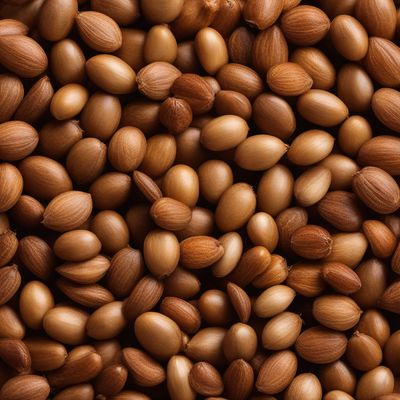
Ingredient
Kersting's groundnut (fresh seeds)
The African Delicacy with Nutty Goodness
Kersting's groundnut is a small, kidney-shaped legume with a thin, brownish-red skin. The seeds have a creamy white interior and a distinct nutty flavor. They have a firm yet tender texture, similar to other legumes like peanuts or chickpeas. Kersting's groundnut is highly versatile and can be used in both sweet and savory dishes, adding a delightful nuttiness and protein-rich goodness.
Origins and history
Kersting's groundnut is native to West Africa and has been cultivated for centuries. It is named after the German botanist, Hermann Kersting, who extensively studied the plant in the early 20th century. This legume is particularly important in the culinary traditions of countries like Ghana, Nigeria, and Burkina Faso, where it is used in various dishes such as soups, stews, porridges, and snacks. Kersting's groundnut is not only a delicious ingredient but also plays a significant role in the local economy and food security.
Nutritional information
Kersting's groundnut is a good source of plant-based protein, dietary fiber, and essential minerals such as iron, magnesium, and phosphorus. It is also rich in antioxidants and contains healthy fats. With approximately 150 calories per 1/4 cup serving, Kersting's groundnut provides a satisfying and nutritious addition to meals.
Allergens
Kersting's groundnut may be allergenic to individuals with peanut allergies, as it belongs to the same botanical family. Cross-reactivity between peanuts and Kersting's groundnut is possible, and caution should be exercised when consuming or handling this ingredient.
How to select
When selecting Kersting's groundnut, look for fresh seeds that are plump, firm, and free from any signs of mold or damage. The skin should be intact and without blemishes. Avoid any seeds that appear shriveled or discolored, as this may indicate poor quality or age. If purchasing from a farmers market, ask the vendor about the freshness and storage conditions of the seeds.
Storage recommendations
To maintain the freshness and quality of Kersting's groundnut seeds, store them in a cool, dry place in an airtight container. Avoid exposure to moisture or direct sunlight, as this can cause the seeds to spoil or become rancid. Properly stored Kersting's groundnut seeds can last for several months.
How to produce
Kersting's groundnut can be grown in warm climates with well-drained soil. It requires a frost-free growing season and thrives in full sun. The seeds can be sown directly in the ground or started indoors and transplanted once the risk of frost has passed. Regular watering and proper weed control are essential for successful cultivation. Harvest the pods when they turn brown and dry, then shell the seeds and store them in a cool, dry place.
Preparation tips
Kersting's groundnut seeds can be boiled, roasted, or ground into flour for various culinary applications. They are commonly used in soups, stews, and porridges, adding a rich nutty flavor and protein content. The seeds can also be roasted and enjoyed as a snack or ground into flour for baking bread, cakes, or pancakes. In some African countries, Kersting's groundnut is used to make a traditional beverage called kunu" or incorporated into local snacks like "kulikuli" or "akara.""
Culinary uses
Kersting's groundnut is widely used in West African cuisine, particularly in countries like Ghana, Nigeria, and Burkina Faso. It is a key ingredient in traditional dishes such as groundnut soup, maafe (peanut stew), or kuli-kuli (groundnut snack). Kersting's groundnut is also used to make flour for baking bread or cakes. Additionally, it is consumed as a roasted snack or incorporated into local beverages and snacks.
Availability
Kersting's groundnut is primarily cultivated and consumed in West Africa, particularly in countries like Ghana, Nigeria, Burkina Faso, and Mali. It is also grown in other parts of Africa, including Sudan and Ethiopia. Outside of Africa, Kersting's groundnut is less commonly available and may be found in specialty African food stores or online retailers.

